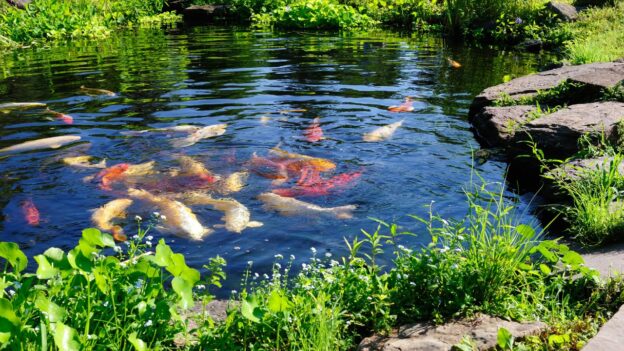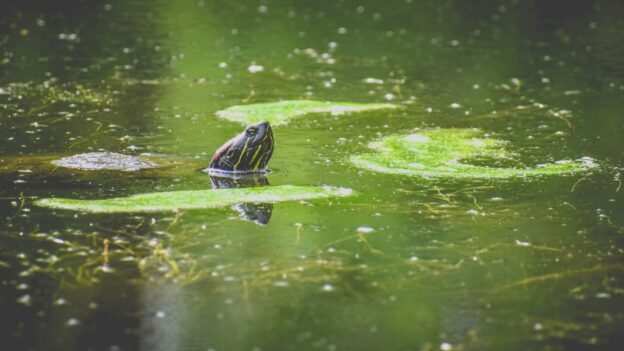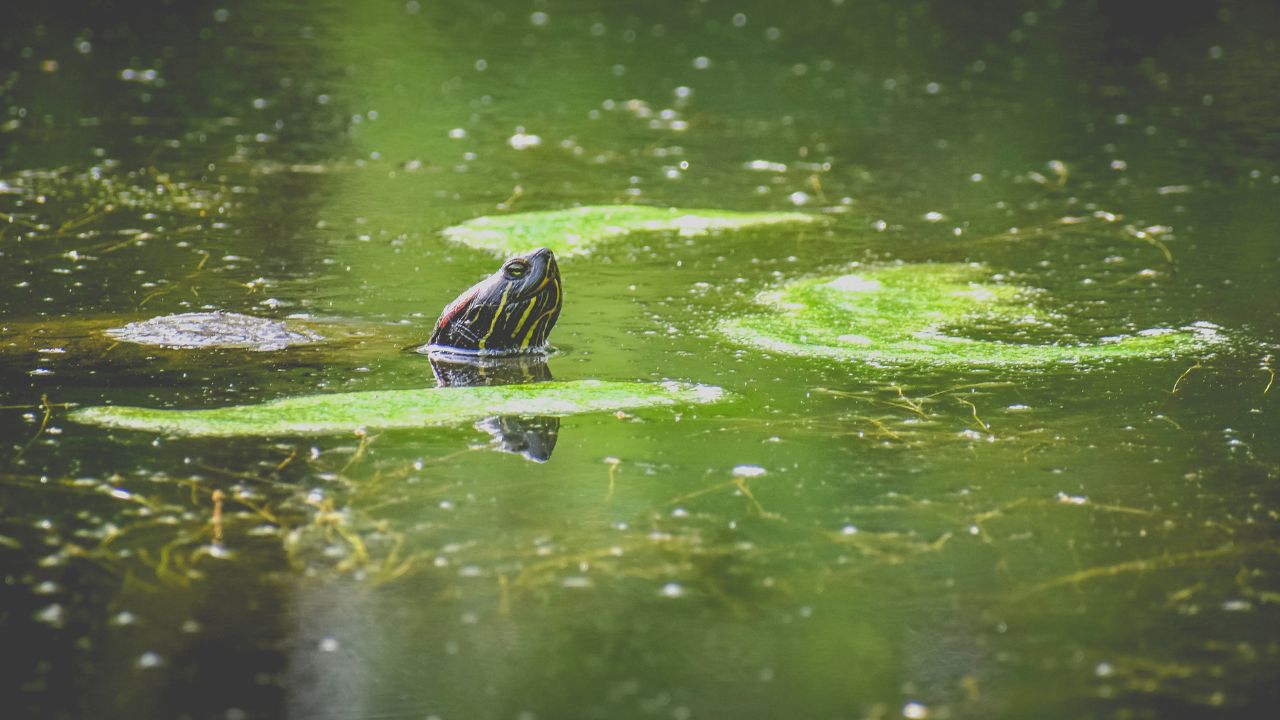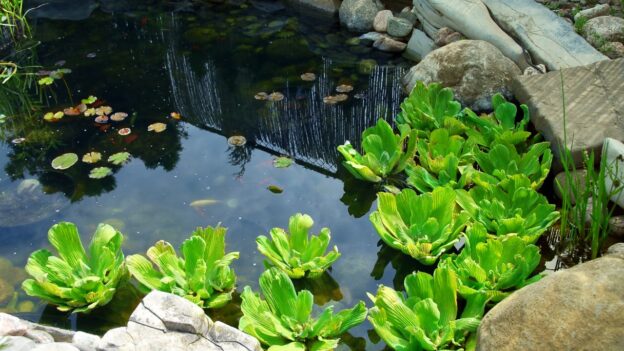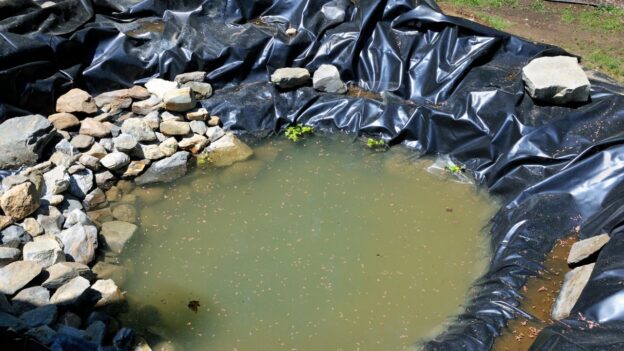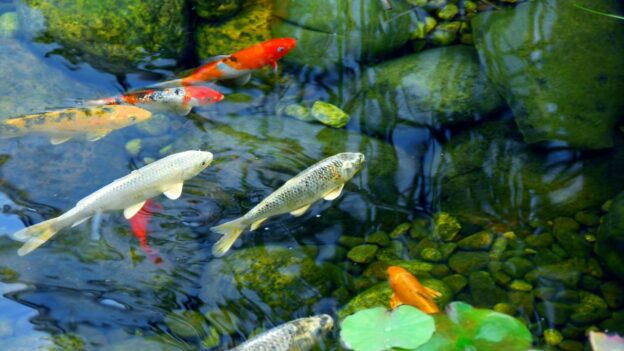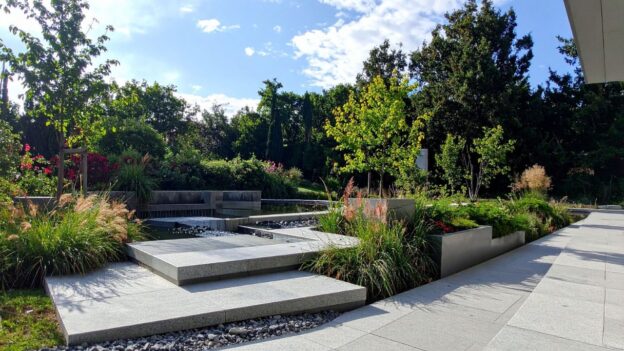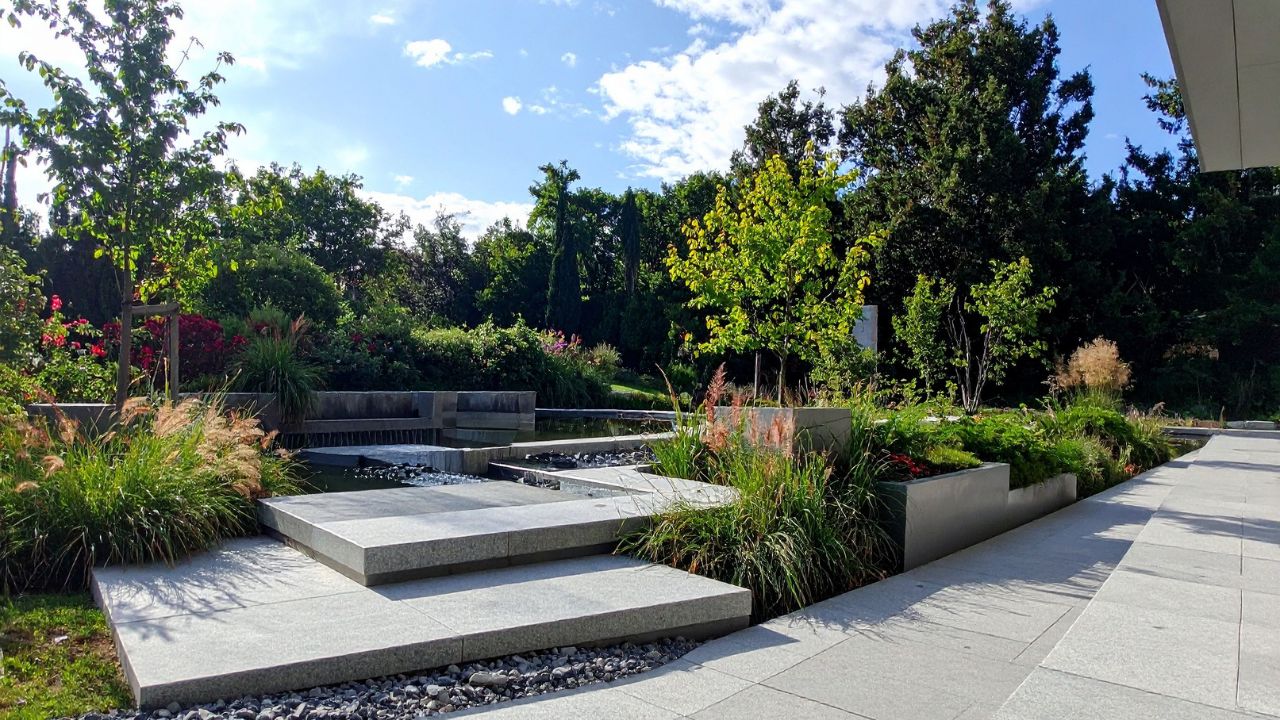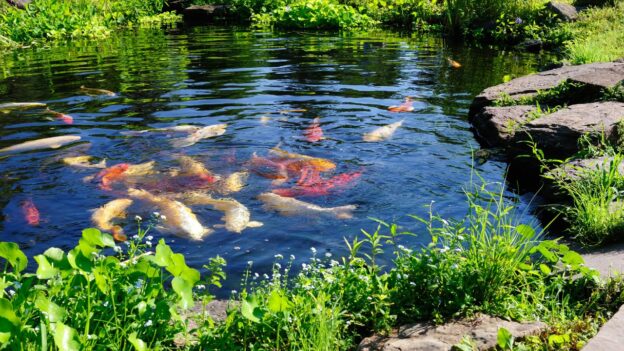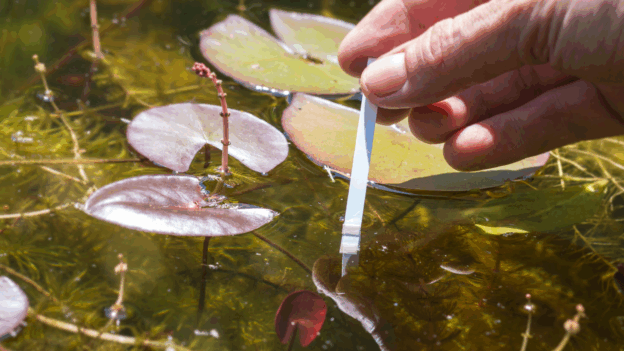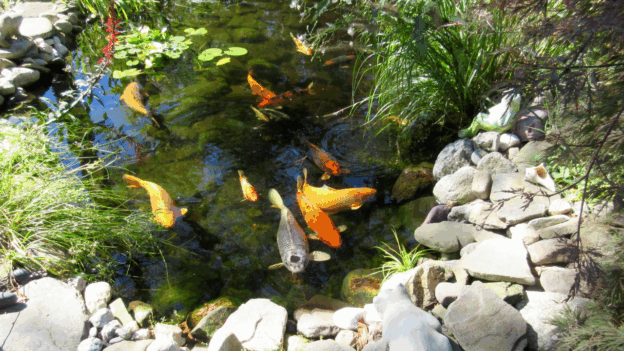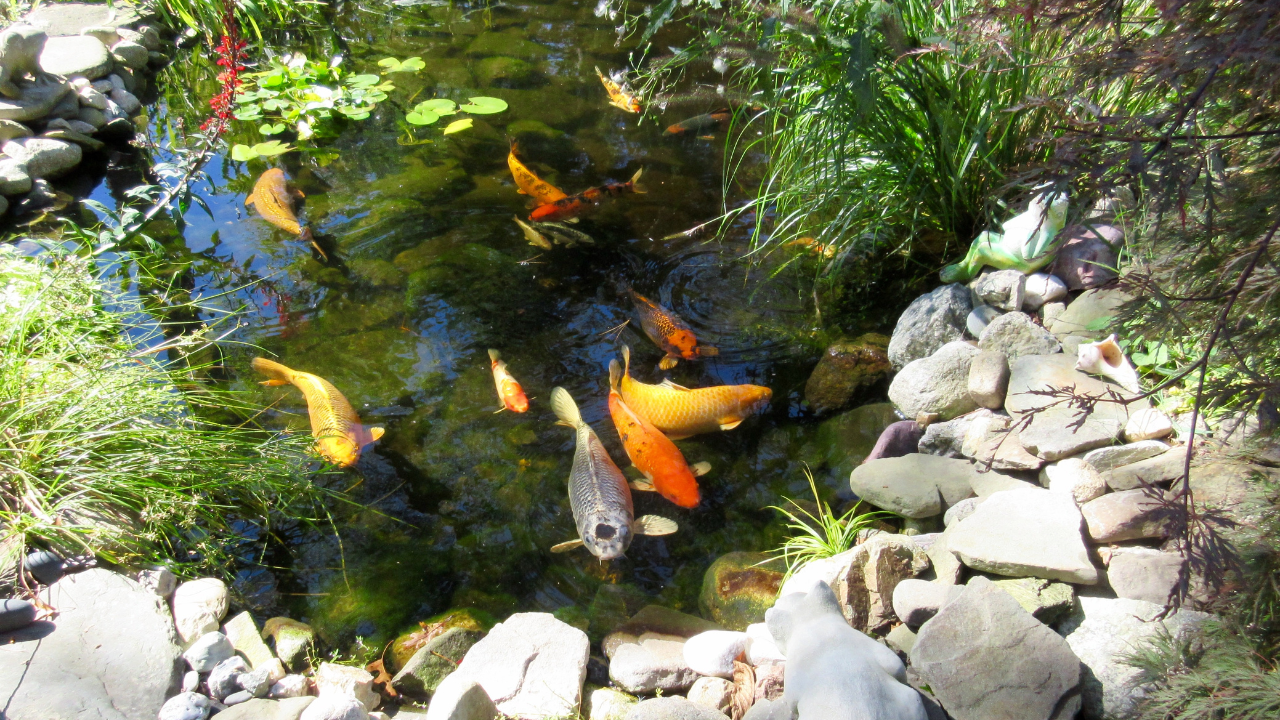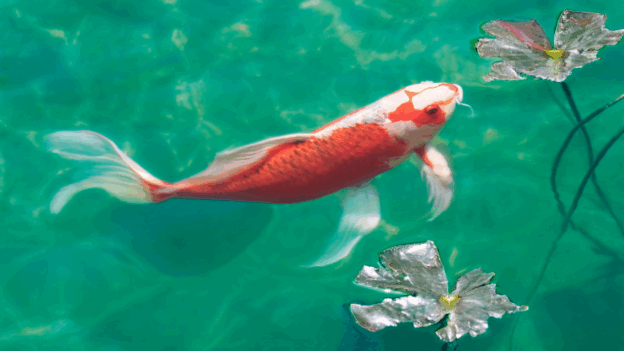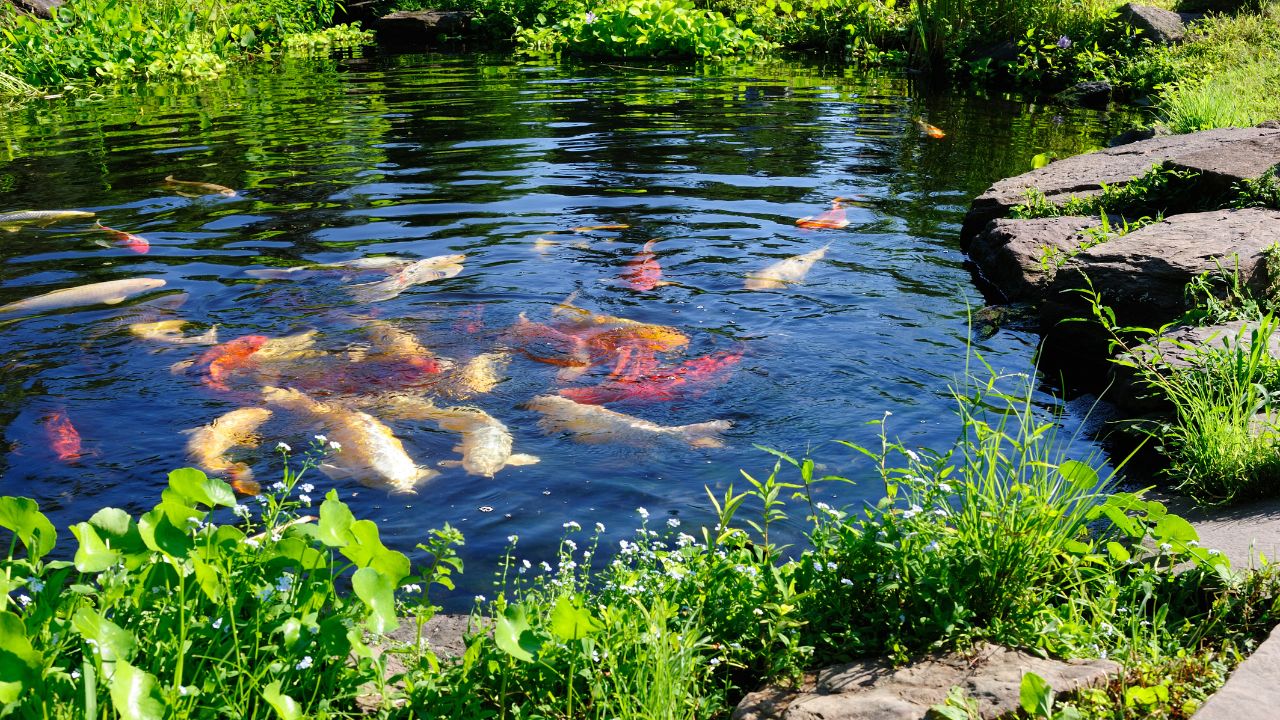
Key Takeaways:
- UV lights clear green water in 10 days by damaging algae DNA at 254 nanometers, causing cells to clump for easy filter removal.
- Clarifiers need 10 watts per 1,000 gallons; sterilizers require 30 watts per 1,000 gallons for pathogen control in koi ponds.
- UV only works on free-floating planktonic algae—it has zero effect on string algae, attached growth, or suspended sediment.
- Flow rate determines success: water must cycle through the UV every 2-3 hours with total pond circulation of 4-6 times per hour.
- Dirty quartz sleeves block 50-80% of UV penetration—clean every 4-8 weeks and replace bulbs annually for consistent results.
Pond owners battling persistent green water often wonder if UV lights deliver real results or just marketing promises. The answer is scientifically definitive: UV clarifiers work exceptionally well for free-floating algae that turns water into murky green soup, typically clearing ponds within 10 days. However, effectiveness depends entirely on proper sizing, installation, and understanding what UV can and cannot fix. This guide breaks down the science, applications, and practical realities of UV technology.
What does a UV light do in a pond, and why is it used for water clarity?
UV lights eliminate microscopic organisms as water flows through an enclosed chamber. The technology uses germicidal light at 254 nanometers to physically damage algae and pathogens at the cellular level, restoring crystal-clear water by targeting planktonic algae responsible for green water.
How does UV target free-floating algae at the cellular level?
UV-C radiation at 254 nanometers penetrates algae cell walls and strikes their DNA. This energy causes pyrimidine dimers to form—adjacent bases in the DNA strand bond together abnormally. The structural damage prevents DNA replication, rendering algae sterile. The damaged cells then clump together through flocculation, creating larger particles that mechanical filters easily capture and remove.
What role does UV play in reducing harmful bacteria without treating the whole pond?
UV sterilizers use higher doses than clarifiers to kill bacteria, viruses, and parasites—critical for koi ponds where disease prevention matters. The treatment targets only free-floating pathogens. While high-dose sterilizers can eliminate some beneficial bacteria, the impact remains minimal because most beneficial nitrifying bacteria colonize the biological filter media, not the water column.
Why does a UV clarifier only work on water that passes through the system?
UV has zero residual effect. Treatment occurs exclusively inside the sealed chamber as water flows past the bulb. Only microorganisms physically pumped through the unit receive exposure. This is why proper circulation matters—the entire pond volume must cycle through the UV unit regularly to maintain clarity.
Why do ponds turn green, and what problem is UV technology designed to solve?
Green water develops from single-celled planktonic algae suspended throughout the water column. These organisms thrive when nutrients from fish waste, intense sunlight, and warm temperatures align. UV specifically addresses planktonic algae by sterilizing free-floating cells during circulation.
How do high nutrient loads and sunlight intensity drive Southern California algae growth?
Southern California’s 300+ sunny days annually create ideal photosynthesis conditions year-round. Long sunny days and warm temperatures extending through fall keep pond temperatures elevated longer than in northern climates, meaning extended algae-growth seasons. When nutrient loads from fish feeding accumulate in these sun-drenched ponds, blooms develop quickly and persistently.
What algae types respond to UV, and which ones (string algae/bottom algae) do not?
UV excels against one type only: free-floating planktonic algae, causing green water. These single-celled organisms remain suspended and pass through the UV chamber during circulation. UV has absolutely no effect on filamentous algae (string algae), blanketweed, or any algae attached to surfaces. These attached forms never flow through the unit, so they never receive exposure. Pond owners need UV for water clarity, plus manual removal or nutrient control for attached growth.
How does insufficient mechanical or biological filtration worsen clarity issues?
Poor filtration creates perfect conditions for persistent algae. Inadequate mechanical filtration leaves debris that feeds algae and blocks UV light. When biological filtration falls short, ammonia and nitrite levels rise, providing nutrients that fuel explosive growth. UV can sterilize algae cells, but without robust mechanical filtration to capture clumped algae, dead cells recirculate and cloud water.
How does a UV clarifier work from a technical and biological standpoint?
UV clarifiers control exposure time and light intensity through precise system design. A UV-C bulb housed inside a protective quartz sleeve sits within a sealed chamber. As water flows past the bulb, germicidal radiation damages algae DNA. Effectiveness depends on three factors: bulb wattage, flow rate, and water clarity.
How do wattage, bulb type, and UV-C exposure time affect algae control?
The distinction between clarifiers and sterilizers lies in UV dose delivery. Clarifiers use moderate doses sufficient to damage algae DNA and trigger flocculation—typically 10 watts per 1,000 gallons. Sterilizers employ much higher doses through increased wattage (30 watts per 1,000 gallons or more) or slower flow rates. These elevated doses don’t just sterilize algae—they kill bacteria, viruses, and parasites for disease prevention.
Why does flow rate determine whether algae cells receive enough exposure?
Flow rate controls how long each algae cell remains in the UV chamber’s kill zone. Water racing through at high speeds gives cells only milliseconds of exposure—insufficient for DNA damage. Slower flow extends exposure time. For effective clarification, water should cycle through the UV unit at least once every 2-3 hours. The overall system must circulate the total pond volume 4-6 times per hour—a 1,000-gallon pond requires 4,000-6,000 gallons per hour.
How do quartz sleeves, chamber design, and water turbidity influence performance?
Water turbidity dramatically impacts UV effectiveness by blocking light penetration. Suspended particulates absorb, scatter, and reflect UV rays before reaching algae cells. Even the thin film on the quartz sleeve reduces UV transmission significantly. This makes pre-filtration absolutely critical—mechanical filtration must remove debris before water enters the UV chamber. Clean quartz allows maximum penetration; dirty sleeves can reduce effectiveness by 50% or more.
Does UV work for all pond types, or only in specific pond conditions?
UV performs best in ponds with strong circulation, adequate pre-filtration, and balanced water chemistry. The system requires water to actually flow through the unit, meaning ponds with proper pump sizing see far better results than those with weak circulation.
How do koi ponds react differently due to higher waste production and bio-load?
Koi ponds generate substantial waste, creating elevated nutrients that fuel aggressive algae growth. Dense populations also increase disease risk, making UV sterilization particularly valuable. During summer, when feeding peaks and metabolic rates soar, the biological load reaches maximum levels. This creates conditions where UV sterilizers—not just clarifiers—become essential for both waste management and disease prevention.
Can UV clarify ponds with low circulation, oversized plant zones, or heavy debris?
UV struggles in ponds with circulation problems or excessive organic loading. Oversized plant zones create stagnant areas where water doesn’t circulate through the UV unit. Heavy debris loads overwhelm mechanical filtration, leaving particulates that block UV light. Ponds with inadequate pump sizing may not achieve the necessary 4-6 volume turnovers per hour. UV installation alone won’t solve these problems—owners must first address circulation issues.
When is UV insufficient because the pond is out of balance chemically or biologically?
Chemical imbalances render UV ineffective regardless of proper sizing. UV sterilizes algae but cannot remove excess nutrients fueling growth. When ammonia and nitrite climb due to insufficient biological filtration, blooms return continuously. UV treats symptoms (green water) but not root causes (nutrient overload). Different filter types excel in different areas—Moving Bed Bioreactors provide superior biological filtration, while pressurized bead filters offer excellent mechanical filtration.
What pond problems can UV fix, and which issues require other solutions?
UV excels at one specific problem: clearing green water caused by planktonic algae. The treatment physically damages algae DNA, causing flocculation and rapid clarification within 10 days. UV sterilizers also reduce bacterial loads. However, UV cannot eliminate turbidity from suspended solids, remove sludge, or address chemistry imbalances.
Can UV eliminate turbidity caused by suspended solids or organic sludge?
UV addresses only living microorganisms, not particulate matter. While the technology flocculates algae into larger clumps for filters to capture, it cannot treat turbidity from clay particles, suspended sediment, or decomposing organic matter. These non-living particles pass through unaffected and actually worsen UV performance by blocking germicidal light. Ponds cloudy from suspended solids need enhanced mechanical filtration, not UV treatment.
When is cloudy water caused by bacterial blooms rather than algae?
Bacterial blooms create white or gray cloudiness distinct from green algae. These blooms typically follow overfeeding or new pond syndrome during biological filter establishment. UV sterilizers effectively kill free-floating bacteria passing through the unit, clearing cloudiness. However, bacterial blooms signal deeper problems—insufficient biological filtration or an unstable nitrogen cycle. UV treats the symptom but won’t prevent recurring blooms unless filtration gets addressed.
Why does UV fail when ammonia, nitrites, or pH are unstable?
Unstable water chemistry indicates the pond ecosystem is fundamentally unbalanced. The biological filter houses beneficial bacteria that convert toxic ammonia to nitrite and then to nitrate—a process that takes several weeks to establish. UV only targets organisms passing through the unit—it cannot address chemical imbalances or accelerate bacterial development. UV installation in chemically unstable ponds wastes money because water quality problems continue generating blooms faster than UV can treat them.
When is a UV system the correct solution based on symptoms and water-quality patterns?
UV becomes the right choice when ponds suffer from persistent green water despite adequate filtration and stable chemistry. The telltale sign is water that tests acceptable for ammonia, nitrite, and pH but remains stubbornly green or develops rapid blooms following sunny periods.
What signs show the pond is suffering from suspended algae rather than other clarity issues?
Green water specifically indicates free-floating planktonic algae. The water develops a distinct pea-soup green color that obscures visibility. Unlike string algae growing on surfaces or brown cloudiness from sediment, planktonic algae create uniform coloration throughout the water column. Scooping water in a clear container shows the green tint persists—the cloudiness isn’t from sediment that settles.
How do rapid green-water blooms during summer signal the need for UV?
Summer creates perfect bloom triggers. Fish feed peaks during warm months, generating maximum waste and nutrient loading. Biological filter demand reaches its highest point. Simultaneously, dissolved oxygen levels drop as temperatures rise. Long sunny days provide abundant photosynthetic energy. Ponds experiencing recurring summer blooms despite proper maintenance are ideal candidates for UV installation.
Which measurements (pH, turbidity, nitrate levels) help confirm UV is appropriate?
Water testing reveals whether UV will solve the problem. Acceptable readings for pH (7.0-8.5), ammonia (0 ppm), and nitrite (0 ppm) indicate the biological filter functions properly. Moderate to high nitrate (20-80 ppm) shows the nitrogen cycle is complete, but nutrients exist, fueling algae. High turbidity or visible sediment suggests suspended solids requiring improved mechanical filtration before UV installation.
How do you size a UV system correctly for pond gallonage and ecosystem demands?
Proper UV sizing balances pond volume, desired outcome, and flow rate. The baseline uses wattage requirements per 1,000 gallons. Clarification needs approximately 10 watts per 1,000 gallons, while sterilization requires 30 watts per 1,000 gallons. However, flow rate dramatically affects these numbers—faster flow reduces exposure time, requiring higher wattage.
What wattage ranges work for 1,000–10,000+ gallon ponds?
The industry guideline scales wattage with pond volume. A 1,000-gallon pond needs a 10-watt clarifier or a 30-watt sterilizer. A 3,000-gallon pond requires 30 watts for clarification or 90 watts for sterilization. Large 10,000-gallon ponds demand 100-watt clarifiers or 300-watt sterilizers. These calculations assume optimal flow rates and reasonably clear water. Always consult manufacturer ratings because flow specifications vary significantly between brands.
Why does koi population density require stronger UV than decorative ponds?
Koi ponds carry substantially higher bioloads than decorative gardens. Dense populations produce more waste, generate higher ammonia, and create greater disease risk. The valuable nature of koi justifies investment in sterilization-level UV rather than just clarification. A decorative pond with a few goldfish may function perfectly with a basic clarifier, while a koi pond of identical volume needs 30-40 watts per 1,000 gallons.
How do pump speed and plumbing layout affect exposure and clarity success?
Flow rate determines UV effectiveness more than any other factor. The entire pond volume must circulate 4-6 times per hour through filtration, with water passing through the UV unit at least once every 2-3 hours. A 1,000-gallon pond requires a pump delivering 4,000-6,000 gallons per hour. The UV unit must be sized for this flow rate. Plumbing layout matters because excessive bends or undersized pipes reduce actual flow rates.
How long does it take for UV to clear pond water under different conditions?
UV clarifiers typically deliver visible improvements within 10 days of continuous operation. The timeline varies based on initial algae density, water turbidity, and filtration capacity to remove flocculated algae. Ponds with severe green water and properly sized UV often show clearing within 3-5 days, with complete clarity by day 7-10.
How do turbidity levels and algae density change the timeline for visible results?
Heavy blooms and high turbidity create the longest clearing times. Dense algae populations require more UV treatment cycles. High turbidity blocks UV light penetration, dramatically reducing the dose reaching algae cells. Ponds with moderate green water and low turbidity clear within 5-7 days, while heavily compromised systems may need 14-21 days, even with properly sized equipment.
Why do ponds with existing filtration issues take longer to clear?
Filtration deficiencies sabotage UV performance in multiple ways. Weak mechanical filtration cannot capture flocculated algae clumps, leaving dead cells circulating. Insufficient biological filtration allows nutrients to accumulate, constantly fueling new growth. The UV system fights a losing battle—clearing algae faster than filtration can remove it or control nutrients. These ponds may improve, but never achieve complete clarity until filtration gets upgraded.
What are realistic expectations for 24-hour, 72-hour, and 1-week outcomes?
UV treatment follows a predictable progression. Within 24 hours, initial sterilization begins, though no visible change occurs. At 72 hours, flocculation becomes visible as water takes on a slightly milky appearance. By one week, noticeable clearing appears as mechanical filters capture flocculated material. Complete crystal clarity usually arrives between days 7-10 of continuous operation. Ponds not improving by day 14 likely have sizing issues or filtration deficiencies.
What regular maintenance keeps a UV system working effectively year-round?
UV systems require minimal but critical maintenance. Bulbs gradually lose UV-C output over time despite continuing to illuminate, necessitating annual replacement. Quartz sleeves accumulate deposits that block UV transmission, requiring cleaning every 4-8 weeks, depending on water hardness. Flow monitoring catches problems before they compromise effectiveness.
Why do UV bulbs need replacement at 12 months due to reduced UV-C output?
UV-C bulbs degrade predictably with use, losing germicidal effectiveness long before burning out visibly. The phosphor coating deteriorates, reducing output by 30-50% over 8,000-10,000 operating hours. This occurs regardless of whether the bulb produces visible light. Most manufacturers rate bulbs for 12 months of continuous operation. Running bulbs beyond this period means the system operates below specification. Calendar-based replacement every spring ensures maximum effectiveness through summer when algae pressure peaks.
How often should quartz sleeves be cleaned for proper light penetration?
Maintenance frequency depends on water hardness and organic load. Mineral deposits from hard water accumulate on the sleeve exterior, blocking UV transmission. Biofilm from bacteria coats the surface, further reducing light penetration. In hard-water regions, cleaning every 4-6 weeks maintains optimal performance. Softer water extends intervals to 8-12 weeks. Heavy coating can reduce effectiveness by 70% or more.
When do flow-rate changes signal clogs, biofilm buildup, or pump issues?
Flow decline indicates problems developing in the filtration system. Clogged mechanical filter media restricts water movement, reducing flow through the UV unit. Biofilm accumulation in plumbing creates friction impeding flow. Pump wear reduces output pressure. Regular flow monitoring catches issues early. Maintenance schedules typically call for cleaning every 4-6 weeks. Flow declining before this interval signals excessive bioload or debris accumulation requiring immediate attention.
Is UV safe for koi, goldfish, turtles, or aquatic plants?
UV clarifiers and sterilizers pose zero direct risk to pond inhabitants when properly installed. The UV-C light remains completely contained within the sealed housing, with no exposure to fish, turtles, plants, or beneficial organisms. Only microorganisms suspended in water and pumped through the chamber receive treatment.
Why is UV safe when only the water—not the animals—is exposed?
UV treatment occurs entirely within the enclosed chamber, isolated from the pond environment. Germicidal light cannot penetrate the housing or reach fish, plants, or beneficial bacteria colonizing filter media. Water enters one end, flows past the UV bulb, and exits the other—all within sealed plumbing. The treatment has no residual chemical effect. Once treated water returns to the pond, it carries no ongoing sterilization properties.
How does overly clear water affect fish behavior and plant growth?
Crystal-clear water can alter natural fish behavior. Fish evolved in environments with moderate visibility. Extremely clear water sometimes causes stress, particularly in koi that feel exposed to predators. These fish may exhibit nervous behavior, reduced feeding, or hiding. Adding plants, rocks, or floating vegetation restores psychological security. Aquatic plants generally thrive in clear water since UV doesn’t affect rooted vegetation.
When do ponds need more aeration once UV clarifies water quickly?
UV-driven clarity can unexpectedly affect oxygen levels. Dense algae blooms produce oxygen through photosynthesis during daylight. Eliminating this algae removes a significant oxygen source, particularly in heavily stocked ponds. Summer compounds the problem—warm water holds less dissolved oxygen while fish metabolism peaks. Ponds experiencing rapid clarity improvements during summer heat should monitor fish behavior. Supplemental aeration prevents oxygen stress during peak biological load periods.
How does UV compare to other algae-control or water-clarity methods?
UV provides the fastest, most reliable solution for green-water problems, but doesn’t replace comprehensive pond management. Biological filtration addresses the underlying nutrients fueling algae. Plants compete for nutrients but cannot clear existing blooms. Chemical algaecides kill algae quickly but leave dead organic matter, degrading water quality.
How does UV compare to biological filtration upgrades?
Biological filtration and UV address different aspects. The biological filter houses beneficial bacteria that process toxic ammonia through the nitrogen cycle—a process taking several weeks to establish and directly impacting water quality. UV addresses only the symptom—green water—without improving nutrient processing. Ponds with adequate biological filtration but persistent green water benefit tremendously from UV addition. However, ponds with insufficient biofilter capacity need filtration upgrades first. The two technologies complement rather than replace each other.
Why do plants compete with algae for nutrients but cannot replace UV?
Aquatic plants absorb ammonia, nitrate, and phosphorus that would otherwise fuel algae growth. Heavy planting can significantly reduce bloom frequency by limiting available nutrients. However, plants work preventively over weeks and months—they cannot reverse an existing green-water bloom quickly. Once planktonic algae establish, plants cannot absorb nutrients fast enough to starve them. UV provides rapid intervention, clearing existing blooms within days, while plants maintain long-term nutrient control, reducing future bloom likelihood.
How do algaecides, beneficial bacteria, and shading differ from UV clarity results?
Algaecides kill algae chemically, providing fast results but creating side effects. Dead algae decompose, consuming oxygen and releasing nutrients back. Beneficial bacteria products enhance biological filtration gradually over 2-4 weeks but provide no immediate clarity. Shading reduces algae growth by limiting photosynthesis, working preventatively but not clearing existing blooms. UV delivers physical, cellular-level treatment through DNA damage, producing flocculation and rapid clearing without chemicals or oxygen depletion.
What are the most common mistakes that cause UV systems to fail?
Properly sized UV systems fail when installation or operation errors prevent adequate treatment. Excessive flow rates, dirty quartz sleeves, and pump mismatches account for most performance problems. These issues reduce exposure time or block UV penetration.
Why does excessive flow rate render UV ineffective?
Flow rate directly controls exposure time—too fast means insufficient treatment. Water racing through at excessive speed gives algae cells only brief UV exposure, inadequate for DNA damage. The issue typically stems from oversized pumps installed without considering UV specifications. Manufacturers rate units for specific maximum flow rates. Exceeding these ratings proportionally reduces effectiveness. Water should cycle through the UV unit at least once every 2-3 hours for clarification.
How do dirty sleeves block UV-C penetration entirely?
Quartz sleeve contamination destroys UV effectiveness even with adequate flow rates. Mineral deposits create scaling that absorbs and reflects UV light. Biofilm adds an organic coating, further blocking transmission. Even thin contamination reduces output by 30-40%, while heavy buildup can block 80-90%. Effective pre-filtration becomes essential, removing debris before water enters the chamber. Hard-water regions require more frequent quartz cleaning to prevent mineral accumulation.
What installation errors (placement, pump mismatch) reduce performance?
Placing the UV unit before mechanical filtration exposes it to debris-laden water that blocks light. The unit should always receive pre-filtered water. Pump sizing errors create flow-rate problems—too large means insufficient exposure time, too small means inadequate circulation. The complete system must circulate pond volume 4-6 times per hour, with the UV unit rated for that specific flow. Always consult manufacturer specifications since ratings vary significantly between brands.
When should pond owners seek professional help with UV installation or diagnosis?
Professional assessment becomes necessary when DIY troubleshooting fails to resolve persistent clarity problems. Complex plumbing issues, pump sizing calculations, or diagnostic testing require expertise most homeowners lack. High-value koi ponds particularly benefit from professional design integrating UV with custom filtration.
When do leaks, plumbing restrictions, or pump sizing require expert assessment?
Plumbing problems require professional diagnosis when performance issues resist obvious solutions. Persistent flow decline despite filter cleaning suggests restrictions in buried lines, undersized plumbing, or pump wear requiring flow testing. Leaks around UV connections can introduce air reducing effectiveness. Proper pump sizing involves complex calculations accounting for head pressure, pipe length, elevation changes, and filter resistance—professionals specify pumps that deliver rated flow at actual installation conditions.
How do professionals test whether clarity problems are algae-based or chemistry-based?
Comprehensive water testing differentiates between treatable algae blooms and chemistry failures. Professionals assess whether issues stem from UV-treatable planktonic algae versus filamentous algae, suspended solids, or chemical imbalances. Elevated ammonia or nitrite indicates insufficient biological filtration, requiring correction before UV installation. Microscopic examination identifies specific algae types and determines if planktonic species dominate. This diagnostic approach prevents wasting money on UV when the problem requires different solutions.
Why do koi ponds often require custom filtration plus UV to maintain long-term clarity?
Koi ponds present unique challenges demanding integrated solutions. High fish loads create disease-prevention priorities alongside clarity concerns, requiring sterilization-level UV rather than basic clarification. Dense populations generate substantial waste, demanding both superior biological filtration (like Moving Bed Bioreactors) and excellent mechanical filtration (like pressurized bead filters). Custom filtration design accounts for adult koi size, population density, feeding schedules, and climate factors. Professional installation ensures proper integration—mechanical pre-filtration protecting UV performance, biological filtration maintaining stable chemistry, and UV providing both clarity and pathogen control.
What should pond owners remember about using UV as part of a complete clear-water strategy?
UV technology delivers exceptional results for green-water problems when integrated properly with comprehensive management. The system addresses planktonic algae through cellular-level DNA damage and flocculation, providing rapid clarity improvements visible within 10 days. However, UV cannot replace mechanical filtration, removing debris, biological filtration processing waste, or nutrient-control practices limiting algae fuel.
How does UV integrate with mechanical, biological, and nutrient-control practices?
Complete pond management requires multiple complementary technologies. UV targets and eliminates free-floating planktonic algae through sterilization. Mechanical filtration physically removes debris and flocculated algae clumps that UV creates. Biological filtration processes toxic ammonia through the nitrogen cycle, preventing nutrient accumulation, driving blooms. Each component addresses a distinct aspect—UV handles existing algae, mechanical filtration manages particulates, and biological filtration controls waste and chemistry.
Why does year-round maintenance matter for consistent clarity?
Seasonal adjustments sustain UV effectiveness through changing conditions. Summer demands maximum performance when biological loads peak and algae reproduction accelerates. Winter brings reduced fish metabolism, requiring feeding adjustments and sometimes reduced flow rates to avoid super-cooling. Consistent maintenance schedules—cleanings every 4-6 weeks—prevent performance degradation. Annual bulb replacement ensures adequate UV-C output through the critical summer season. Year-round attention maintains stable clarity rather than fighting recurring blooms.
What clarity improvements should owners realistically expect after proper installation?
Properly installed UV systems deliver dramatic, reliable results for planktonic algae problems. Visible improvements typically appear within 10 days of continuous operation as the technology targets and eliminates free-floating algae through DNA damage and flocculation. Green-water ponds transform to crystal clarity when UV specifications match pond volume, flow rates stay within recommended ranges, and mechanical filtration captures flocculated material effectively. However, UV cannot address filamentous algae on surfaces, suspended sediment, or chemistry problems. Success requires following manufacturer specifications, maintaining clean quartz sleeves, replacing bulbs annually, and ensuring overall filtration manages waste and nutrients effectively.
Transform Your Green Pond into Crystal-Clear Water with Expert UV Solutions
Understanding UV technology is just the beginning—proper installation, sizing, and integration with your existing filtration system determines whether you achieve lasting clarity or disappointing results. Orange County Pond Services specializes in diagnosing water-quality issues, designing custom UV solutions sized correctly for your specific pond conditions, and integrating clarifiers or sterilizers with mechanical and biological filtration for optimal performance.
Whether you’re battling persistent green water, need professional assessment of recurring algae blooms, or want expert UV installation that actually delivers the 10-day clarity transformation, Orange County Pond Services brings the technical expertise and local experience to solve your pond problems permanently. Contact us today for a comprehensive water-quality evaluation and customized UV recommendation that matches your pond’s unique demands.
